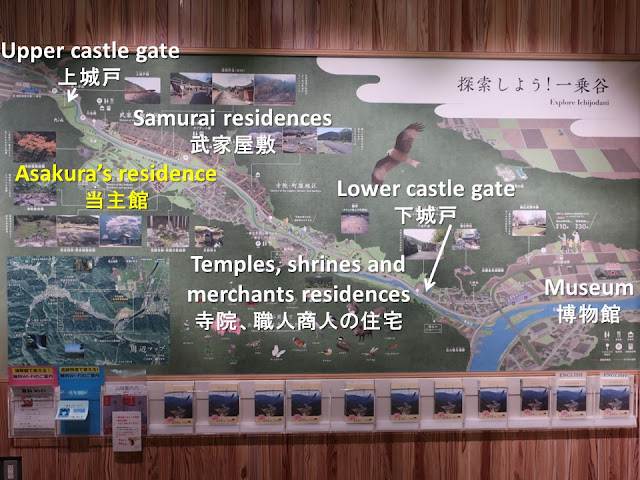The site was a base of Asakura clan who were warlord during the internal wartime in the 15th and the 16th centuries. It is a valley which was easy to defend. The clan summoned their retainers, merchants and craftsmen. They prospered around a hundred years until Oda Nobunaga destroyed them in 1573. Afterward, the valley was covered by soil and became farming fields.
The site has been unearthed since 1967;
more than a million items were excavated, which tell us life in the old days. The
wartime relives.
越前の戦国大名・朝倉氏は、防御に適した一乗谷に家臣や商工業者を住ませ、織田信長に滅ぼされる1573年まで、5代約百年にわたる繁栄を築きしました。滅亡後は、農地となり、土の下に埋もれました。
残された遺跡の発掘が始まったのは1967年から。すでに百万を超える遺物が発掘され、城下の暮らしを教えてくれます。また、建物の復元も進行中。戦国時代が蘇る遺跡です。
The valley is behind the stone monument which says it is a national historic site. Electric wires and poles bother me when I take a photo of a scenery. However, I would like to upload actual photos.
電柱が目立ってしまいますが、この先が、一乗谷です。
In the ruin of the residence of the clan, the main gate was rebuilt. The clan appointed the residents, so they were important people. It is assumed more than ten thousand people lived.
朝倉館跡。一乗谷には、当主に命じられた一万人以上が住んでいたと推定されています。上級領民ですね。左上は復元された唐門。
The stones of the clan’s garden still remain at the same place.
庭園の石組みも残っています。
Some of the mud walls and the houses in the residence area were rebuilt.
復元された住民エリアの土塀。一部の家屋が復元されています。
The room above, which is in a samurai’s house, was built to enjoy view of nature such as moon. It’s cool.
復元武家屋敷には、月見もできる離れ座敷があります。粋ですね。
Around four hundreds of toilets have been found. The rebuilt toilet above (1.8m×1.0m, a stall) has a rectangular hole (1m depth). A part of a toilet was unearthed (lower left). They squatted toilet facing outside, although we sit facing inside now. Did they prepare for enemy?
便所の復元です。約400基の便所が見つかっています。幅約1.8m、奥行き約1mで、深さ約1mの長方形の穴があります。左下は、発掘された金隠し。今と反対で、外側に向いてしゃがむようになっていますね。
Staff wear outfits at that time. It’s a tourist spot.
今風の観光地らしく、物売りや衣装を着けた人もます。
In a carpenter’s house, there is an irori fireplace behind the exhibit.
展示品(大工道具のちょうな)の後ろは囲炉裏。
Its backyard is large enough to farm vegetables for home consumption.
裏庭は広く、野菜なら作れそうです。
The stone side ditch and wells help us imagen the disappeared town. Each house for an ordinary person had one well; samurai house and temple had two or three wells. The valley has a river in center. It is an abundant water area.
石組みの水路や井戸があり、街のイメージが掴めます。町屋で一軒に一基、武家屋敷や寺院では2~3基の井戸がありました。谷の中央を川が流れ、水が豊富です。
The map of the valley is displayed in a nearby museum. The distance of the upper and the lower castle gate is around two kilometers.
I’ll show you the exhibits of the museum in the next article. We can understand their daily life.
上の一乗谷の地図は、一乗谷の直ぐ近くにある一乗谷朝倉氏遺跡博物館で展示されています。城門に当たる上城戸(かみきど)と下城戸の距離は2km弱です。
次の記事では、展示品を紹介します。一乗谷の暮らしが分かります。
Visited in October, 2023
Official website: http://fukuisan.jp/en/asakura/index.html
http://fukuisan.jp/ja/asakura/
(in Japanese, but much info.), accessed in May, 2024
Previous post (museum in the neighboring
city): Hakusan-Heisenji
Shrine and History Hall Mahoroba、平泉寺白山神社と歴史探遊館「まほろば」
Next post (museum regarding this site): Ichijodani Asakura Family Site Museum、一乗谷朝倉氏遺跡博物館












Comments
Post a Comment